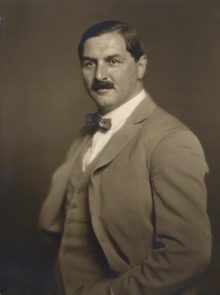Otto Rudolf Salvisberg

Otto Rudolf Salvisberg (19 October 1882, Köniz – 23 December 1940, Arosa) was a Swiss architect.
Between 1905 and 1930 Salvisberg worked in Germany. He worked with Bruno Ahrends and Wilhelm Büning to design the "White City" housing settlement in Berlin.
Biography
After completing his apprenticeship as a building draughtsman, Salvisberg attended the School of Architecture at the Technicum in Biel/Bienne in 1901, which he graduated from in 1904 with honors. Subsequently, he traveled through southern Germany to Munich. In Munich, Salvisberg attended courses at the Technical University of Munich, where August Thiersch, Friedrich von Thiersch, and Karl Hocheder were teaching. Presumably in 1905, he continued his journey to Karlsruhe. In addition to his employment at the architectural firm Curjel & Moser in Karlsruhe, he studied at the Technical University of Karlsruhe under the guidance of Carl Schäfer.[1]
From 1930, Salvisberg taught as a professor at the Swiss Federal Institute of Technology in Zurich, where he built the district heating plant and mechanical engineering laboratory until 1934. In 1938, he spent some time in Turkey. In the 1930s, Salvisberg was the in-house architect for the pharmaceutical company Hoffmann-La Roche, designing the development plan and many buildings at the headquarters in Basel as well as numerous buildings for the subsidiaries around the world.
References
- ^ "Salvisberg, Otto Rudolf". hls-dhs-dss.ch (in German). Retrieved 2023-09-28.
External links
 Media related to Otto Rudolf Salvisberg at Wikimedia Commons
Media related to Otto Rudolf Salvisberg at Wikimedia Commons
- View a machine-translated version of the German article.
- Machine translation, like DeepL or Google Translate, is a useful starting point for translations, but translators must revise errors as necessary and confirm that the translation is accurate, rather than simply copy-pasting machine-translated text into the English Wikipedia.
- Do not translate text that appears unreliable or low-quality. If possible, verify the text with references provided in the foreign-language article.
- You must provide copyright attribution in the edit summary accompanying your translation by providing an interlanguage link to the source of your translation. A model attribution edit summary is
Content in this edit is translated from the existing German Wikipedia article at [[:de:Otto Rudolf Salvisberg]]; see its history for attribution. - You may also add the template
{{Translated|de|Otto Rudolf Salvisberg}}to the talk page. - For more guidance, see Wikipedia:Translation.
- v
- t
- e










